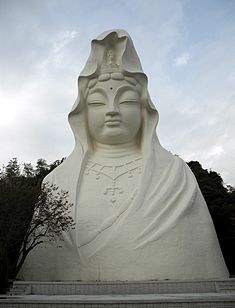- Ōfuna Kannon
-
The Ōfuna Kannon, Ōfuna Kannonji (大船観音寺), or Muga sozan Ōfuna Kannonji is a Buddhist temple in Kamakura, Kanagawa, Japan. The outstanding feature of the temple is a 25 meter tall 1,900 ton reinforced concrete statue of Kan'non which is dedicated to the bodhisattva Kannon or Kuan Yin.
Construction of the Temple began in 1929 by the Sōtō (Zen) Buddhist sect. The outline of the statue was complete by 1934 but work was suspended at the outbreak of the Pacific War. The Ofuna Kannon Society continued construction work in 1954 and the Temple was finally completed in 1960. The statue construction is that of sections of poured concrete and was performed entirely by hand. No concrete pump trucks were used. The surface of the statue is oft painted white. The statue itself contains a small museum and shrine and both are open for viewing.
The Kannon incorporates stones from ground zero of Hiroshima and Nagasaki to commemorate those who died in the explosions of the atomic bombs. A fire originating from the atomic fires of Hiroshima burns in a mushroom-formed statue.
Ōfuna Kannon is close to the Ōfuna Station and has a moderate cost of 300 yen to enter.
This is from the documentation provided if you visit the statue site:
“ The building of the statue of the "goddess of mercy of the white robe" at the Ofuna-Kannon-ji was organized "in general defense of the Fatherland" by Kentaro Kaneko and traditional nationalist Mitsuru Touyama, who had participated in the drafting of the Imperial Constitution. Originally praying for permanent world peace, the goddess of mercy belief spread and in 1929 the building of the statue began. By 1934 the outline of the statue was complete, but the outbreak of war in the Pacific ended this steady progress, bringing extensive damage to the surrounding area and halting work on the statue for the next twenty years.
In 1954 the chief priest of the Soto sect of Zen, Zenji Rosen Takashina, the Minister of Education, Masazumi Andou, Minister of Justice, Ryouzou Makino, and Keita Goto all united in their support of the Ofuna-Kannon project. The Ofuna-Kannon Society was born and restoration of the statue started under the guidance of Yutaka Yamamoto, a professor at the Tokyo University of Arts. Construction was finally completed in 1960.
The Ofuna-Kannon Society was dissolved in 1981. Since then the site has been working as a temple under the direction of the Soji-ji,in Yokohama City. It contains stones carried from ground zero of Hiroshima and Nagasaki, which commemorate the souls of these who died as a result of the atomic bomb attacks
The Ofuna-kannon-ji is part of the Kamakura Distrrict, but due to its location it doesn't form part of the series temples and shrines that are popular amongst sightseers visiting Kamakura City. As a result, those who call at Ofuna-Kannon will find that over 60% of their fellow visitors are individuals with a critical belief who visit the temple on a regular basis for spiritual purposes.
Despite Asia's cultural diversity certain symbols and icons are visible throughout, providing common links between various nationalities. Kannon is such a symbol, and her statue at Ofuna provides a welcome sense of familiarity to foreigners living in
Japan who seek her out as a source of comfort during periods of solitude and homesickness. The goddess of mercy carries the prayers for peace of foreigners and Japanese citizens alike-the universality of this belief is celebrated every autumn in the Yume-Kannon festival. This festival is an opportunity for foreigners in Japan to show their belief in Kannon through song, dance, and traditional stalls. The celebrations take place in September, and all are invited to set up a stall, showcasing their vegetarian foods and other traditional items from their native country.
Thank you for visiting the temple today.
” See also
- For an explanation of terms concerning Japanese Buddhism, Japanese Buddhist art, and Japanese Buddhist temple architecture, see the Glossary of Japanese Buddhism.
- List of statues by height
References
Coordinates: 35°21′10.35″N 139°31′43.01″E / 35.352875°N 139.5286139°E
Buddhism Buddhist temples in Japan Japanese Buddhist architecture Architectonic elements Mon (gates) Buildings Chinjusha · chōzuya/temizuya · -dō · main hall (kon-dō, hon-dō, butsuden) · kuri · kyōzō or kyō-dō · shoinTō or Buttō (pagodas) Styles Others A-un · kenSchools and objects of worship Major schools Zen schools Nanto rokushū Objects of worship Amida Nyōrai · Benzaiten · Dainichi Nyorai · Jizō · Kannon · Marishi-ten · Shaka Nyorai · Shitennō (Four Kings) · Twelve Heavenly Generals (Jūni Shinshō) · Yakushi NyoraiOther elements Implements kei (ritual gong) · mokugyōOthers bussokuseki · butsudan · Glossary of Japanese Buddhism · Japanese Buddhist pantheon · jingū-ji · miyadera · saisenbakoCategories:- Buddhist temples in Kanagawa Prefecture
- Concrete sculptures
- Buddhism stubs
- Japan religion stubs
- Japanese building and structure stubs
Wikimedia Foundation. 2010.

